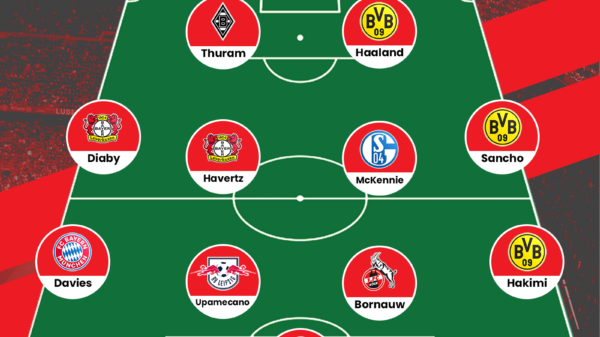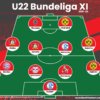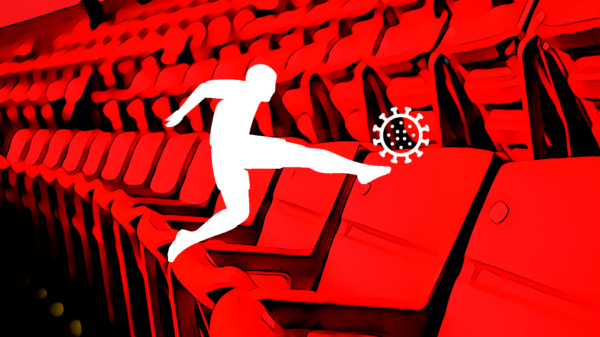Nicolas Pernigotti’s latest piece is a detailed tactical analysis of the Bundesliga match between Monchengladbach and Dortmund.
In the return of the Bundesliga, Tuchel´s BVB gave dealt a severe blow to Borussia Mönchengladbach beating them as they did in the first round of the league, when they won 4-0. Although in this case the tactics and the circumstances were very different from that encounter.
MONCHENGLADBACH 1-3 DORTMUND
Lineups

Borussia Monchengladbach: (4-4-2) Sommer; Korb, (Drmic 90+2′), Christensen, Elvedi (Hinteregger 80′), Wendt; Traore, Dahoud (Hoffmann 90′), Nordtveit, Johnson; Raffael, Stindl.
Borussia Dortmund: (4-3-3) Burki; Pisczcek, Sokratis, Hummels, Park; Gundogan, Weigl, Castro (Durm 70′); Reus (Ginter 70′), Mkhitaryan, Aubameyang (Ramos 76′).
Schubert, like Tuchel fielded almost a full strength team; while Xhaka was the most significant absence for the home team, Schmelzer was the most important missing player for Dortmund.

Against BVB, Gladbach began without the two new additions, Hinteregger and Hofmann, with a clear 4-4-2 as Schubert abandoned the triple chain, which he used against Bayern with some success. Without possession of the ball, the 4-4-2 was combined with man marking, but Dortmund broke the shackles too many times for it to be considered effective.
The choking pressure from Gladbach
Undoubtedly, this was the most important match of round 18 of the Bundesliga and it lived up to expectations. Within five minutes both teams showed similar intentions, with their strategy out of possession being high pressing a high defensive line. Both teams tried this, but Gladbach took it to the extreme.
During the first 30 minutes of play, the intensity in the central area was very high, so much so that both teams found it difficult to move their blocks and get away from the congestion. The fast pace and constant pressing forced to Dortmund long passes, certainly more long passes than they had planned to.

Weigl and Gündogan key for Dortmund
Dortmund set part of their defensive strategy to accentuate the participation of Julian Weigl, the prodigal “aurinegro”, and got him ahead of one of their midfielders, transforming the 4-4-2 into a 4-3-1-2 while attacking. However, although this part of the plan was useful, the home team suffered when Burki or Hummels placed balls behind the second defensive line. In fact, with this formula Tuchel´s team looked much better. In the image we see the goal as a result of the penetration of three attackers, who misplace the defensive line of Gladbach, with a precise pass from Gündogan leaving only Reus to score.

When the high pressing of the home team had no effect, Dortmund settled with their positional play in the opposition half but showed some differences from their usual behavior: The full backs were not so aggressive; the wings were kept open and wingers did not play with their usual tendency of cutting inside.
Aubameyang too, changed his patterns, and made more vertical than horizontal runs. We see Weigl (red circle) is located between the lines, while the wingbacks, wingers and central midfielders form an offensive triangle in both bands generating numerical superiority in the 1 x 1 against the defensive scheme applied by Schubert.

With Gündogan much deeper and Bürki participating with his feet as much as necessary, Dortmund were endowed with greater fluidity in the initiation phase of the game and got into their stride quickly.
The perfect counterattack
The growing authority of the visiting side also had to do with the good movement of Mkhitaryan from the left side and, of course, the courage of Hummels to break lines and find the open man.
After 50 minutes, Hummels made a superb interception that then reached, Gündogan, who before crossing midfield gave the ball to Reus; This in turn led to a pass to Pierre Emerick (which cleared the way for Mkhitaryan’s run) and assisted the delicate number 10.

When it looked like it might be a quiet victory for Tuchel, a melee in the Dortmund penalty area allowed Raffael to score and make it 1-2, leaving the game hanging in the balance again.
After the goal, Tuchel reinforced his midfield, with Ginter and Durm replacing Castro and Reus respectively. He effectively substituted creativity for good defending and fast counterattacks.
Conclusion
Dortmund is aware of the difficult job they have to catch up with FC Bayern, but they have one of the strongest teams in Europe. On the back of this effort, Gladbach certainly need to improve and get back on the road that they surprisingly found themselves on after the dismissal of Favre.
Written by Nicolas Pernigotti
- Tactical Analysis: Juventus 2-2 Bayern Munich | Allegri’s 4-4-2 and critical change of pace in second half - February 29, 2016
- Tactical Analysis: Monchengladbach 1-3 Dortmund | Effective counter attacks work for Dortmund - January 28, 2016
- Tactical Analysis: River Plate 0-3 Barcelona | Barca’s enterprising play too much for River - December 28, 2015


























































